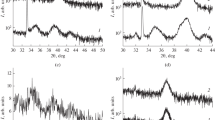The formation and growth of crystalline structures on the surface of tungsten wires at normal pressure in air are studied. It is found that crystalline structures are formed on the oxidized tungsten wires at 980 K. Their shape changes from whiskers to dendrites with increasing temperature during oxidation. The longitudinal and transversal growth rates of the structures are determined. The mechanism of formation and growth of oxide crystals on tungsten wires at high temperatures is proposed. It is proved that carbon atoms on the surface of a tungsten wire are nuclei for WO3 crystallization from the gaseous phase.





Similar content being viewed by others
References
I. E. Wachs, T. Kim, and E. I. Ross, “Catalysis science of the solid acidity of model supported tungsten oxide catalysts,” Catalysis Today, 116, 162–168 (2006).
A. Hameed, M. I. Ismail Iqbal, M. Aslam, and M. A. Gondal, “Photocatalytic conversion of methane into methanol: performance of silver impregnated WO3,” Appl. Catal. A, 470, 327–335 (2014).
G. D. Barton, S. L. Soled, and E. Iglesia, “Solid acid catalysts based on supported tungsten oxides,” Topics Catal., 6, No. 1–4, 87–99 (1998).
G. Xie, J. Yu, X. Chen, and Y. Jiang, “Gas sensing characteristics of WO3 vacuum deposited thin films,” Sens. Actuators B, 123, No. 2, 909–914 (2007).
V. V. Barelko, V. G. Abramov, and A. G. Merzhanov, “Thermographic method of studying the kinetics of gas-phase heterogeneous catalytic reactions,” Zh. Fiz. Khim., 43, No. 11, 2828–2829 (1969).
S. G. Orlovskaya, M. S. Shkoropado, and F. F. Karimova, “High-temperature oxidation and destruction of metal filaments in air,” Ukr. Fiz. Zh., 56, No. 12, 1312–1315 (2011).
S. G. Orlovskaya, F. F. Karimova, and M. S. Shkoropado, “Formation of oxides on tungsten conductors heated by electric current,” Powder Metall. Met. Ceram., 49, No. 5–6, 351–354 (2010).
P. Kofstad, High Temperature Oxidation of Metals, John Wiley & Son, New York (1966).
I. N. Frantsevich, R. F. Voitovich, and V. A. Lavrenko, High-Temperature Oxidation of Metals and Alloys [in Russian], Gostekhizdat, Kyiv (1963), p. 324.
I. V. Semenova, G. M. Florianovich, and A. V. Khoroshilov, Corrosion and Corrosion Protection: University Textbook [in Russian], Fizmatlit, Moscow (2006), p. 376.
Yu. S. Karabasova, News Materials [in Russian], Mosk. Univ. Stali Splavov, Moscow (2002), p. 736.
S. G. Orlovskaya, M. S. Shkoropado, Yu. A. Shevchenko, and A. O. Odnostalko, “Study of high-temperature heat and mass exchange and oxidation of refractory metal samples in air,” Fiz. Khim. Tverd. Tela, 15, No. 2, 384–387 (2014).
M. T. Chang, L. J. Chou, Y. U. Chueh, et al., “Nitrogen-doped tungsten oxide nanowires: low-temperature synthesis on Si, and electrical, optical and field-emission properties,” Small, 3, No. 4, 658–664 (2007).
T. Tokunaga, T. Kawamoto, K. Tanaka, et al., “Growth and structure analysis of tungsten oxide nanorods using environmental TEM,” Nanoscale Res. Lett., 7, No. 1, 1–7 (2012).
B. W. Mwakikunga, A. Forbes, E. Sideras-Haddad, and C. Arendse, “Optimization, yield studies and morphology of WO3 nano-wires synthesized by laser pyrolysis in C2H2 and O2 ambients—validation of a new growth mechanism,” Nanoscale Res. Lett., 3, No. 10, 372–380 (2008).
S. M. Cui, G. H. Lu, S. Mao, et al., “One-dimensional tungsten oxide growth through a grain-by-grain buildup process,” Chem. Phys. Lett., 485, No. 1–3, 64–68 (2010).
B. M. Smirnov, “Fractal clusters,” Usp. Fiz. Nauk, 149, No. 2, 177–219 (1986).
A. N. Zelikman and B. G. Korshunov, Metallurgy of Rare Metals [in Russian], Metallurgiya, Moscow (1991), p. 432.
Author information
Authors and Affiliations
Corresponding author
Additional information
Translated from Poroshkovaya Metallurgiya, Vol. 55, Nos. 11–12 (512), pp. 129–136, 2016.
Rights and permissions
About this article
Cite this article
Shkoropado, M.S., Orlovskaya, S.G. & Shevchenko, Y.A. Studying the Kinetics and Mechanism of Crystal Growth on Tungsten Wires in Normal Conditions. Powder Metall Met Ceram 55, 739–744 (2017). https://doi.org/10.1007/s11106-017-9862-z
Received:
Published:
Issue Date:
DOI: https://doi.org/10.1007/s11106-017-9862-z



